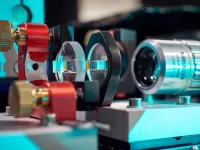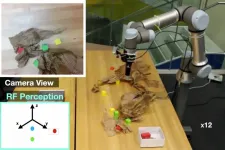INFORMATION:
Origin of modern rainforests traced to end-Cretaceous asteroid impact
2021-04-01
(Press-News.org) In an analysis of thousands of fossil pollen and leaves spanning the Cretaceous-Paleogene (K/Pg) boundary, researchers found that the cataclysmic asteroid impact that resulted in the destruction of nearly 75% of all terrestrial life on Earth drastically restructured tropical forests, setting the stage for the evolution of what has become one of the planet's most diverse ecosystems - the neotropical rainforest. While the end-Cretaceous impact nearly 66 million years ago was catastrophic for terrestrial ecosystems worldwide, its long-term effects on tropical forests have remained a mystery. This is largely due to the lack of palaeobotanical exploration in the region, which has only just begun to provide the data needed to evaluate these questions. Mónica Carvalho and colleagues used fossil pollen and leaves recovered from Colombia to characterize how the impact changed South American tropical forests, finding large-scale changes in species composition and forest structure. According to the findings, late Cretaceous rainforests were characterized by an open canopy environment. However, plant diversity declined by roughly 45% at the K/Pg boundary and extinctions were widespread, particularly among seed-bearing plants. While the forests recovered over the subsequent six million years, angiosperms, or flowering plants, came to dominate the forests. This transition led to the closed canopy structure and the layered, vertical distribution of plant biodiversity that defines modern tropical rainforests. In an accompanying Perspective, Bonne Jacobs and Ellen Currano discuss how the findings from this study and others demonstrate that the recovery and lasting effects of the K/Pg impact and extinction event were variable and depended largely on proximity to the crater and local conditions such as climate. "Today, the world is experiencing a sixth mass extinction event, but this time, there is no place on Earth far from the ultimate cause - humans," write Jacobs and Currano. "It seems that proximate perturbations are and will be substantial everywhere, even if they vary."
ELSE PRESS RELEASES FROM THIS DATE:
How dopamine drives hallucination-like perception in mice
2021-04-01
An increase of dopamine in the brain's striatum triggers auditory hallucination-like experiences in mice, revealing a possible causal role for dopamine-dependent neurological circuits in symptoms of psychosis. These findings from a new study could inform novel targeted approaches to treating those with psychotic disorders, like schizophrenia. Auditory and visual hallucinations - perceptions of hearing or seeing something without observing external sensory stimuli - are central symptoms of psychotic disorders and are thought by some to be caused by excessive dopamine ...
A new state of light
2021-04-01
A single "super photon" made up of many thousands of individual light particles: About ten years ago, researchers at the University of Bonn produced such an extreme aggregate state for the first time and presented a completely new light source. The state is called optical Bose-Einstein condensate and has captivated many physicists ever since, because this exotic world of light particles is home to its very own physical phenomena. Researchers led by Prof. Dr. Martin Weitz, who discovered the super photon, and theoretical physicist Prof. Dr. Johann Kroha have returned from their latest "expedition" into the quantum world with a very special observation. They report of a new, previously ...
Capturing the complex
2021-04-01
(Santa Barbara, Calif.) -- Despite the fact that our planet is mostly ocean and human maritime activity is more intense than it has ever been, we know remarkably little about the state of the ocean's biodiversity -- the variety and balance of species that support healthy and productive ecosystems. And it's no surprise -- marine biodiversity is complex, human impacts are uneven, and species respond differently to different stressors.
"It is really hard to know how a species is doing by just looking out from your local coast, or dipping underwater on SCUBA," said Ben Halpern, a marine ecologist at the Bren School of Environmental Science & Management at UC Santa ...
Mice with hallucination-like behaviors reveal insight into psychotic illness
2021-04-01
The humble lab mouse has provided invaluable clues to understanding diseases ranging from cancer to diabetes to COVID-19. But when it comes to psychiatric conditions, the lab mouse has been sidelined, its rodent mind considered too different from that of humans to provide much insight into mental illness.
A new study, however, shows there are important links between human and mouse minds in how they function -- and malfunction. Researchers at Washington University School of Medicine in St. Louis devised a rigorous approach to study how hallucinations are produced in the brain, providing a promising entry point to the development of much-needed new therapies for schizophrenia.
The study, published April 2 in ...
Flowers!
2021-04-01
Tropical rainforests today are biodiversity hotspots and play an important role in the world's climate systems. A new study published today in Science sheds light on the origins of modern rainforests and may help scientists understand how rainforests will respond to a rapidly changing climate in the future.
The study led by researchers at the Smithsonian Tropical Research Institute (STRI) shows that the asteroid impact that ended the reign of dinosaurs 66 million years ago also caused 45% of plants in what is now Colombia to go extinct, and it made way for the reign of flowering plants in modern tropical rainforests.
"We wondered how tropical rainforests changed after a drastic ecological perturbation such as the Chicxulub impact, so we looked for tropical plant fossils," said Mónica ...
How brain cells repair their DNA reveals "hot spots" of aging and disease
2021-04-01
LA JOLLA--(April 1, 2021) Neurons lack the ability to replicate their DNA, so they're constantly working to repair damage to their genome. Now, a new study by Salk scientists finds that these repairs are not random, but instead focus on protecting certain genetic "hot spots" that appear to play a critical role in neural identity and function.
The findings, published in the April 2, 2021, issue of Science, give novel insights into the genetic structures involved in aging and neurodegeneration, and could point to the development of potential new therapies for diseases such Alzheimer's, Parkinson's and other age-related dementia disorders.
"This research shows for the first time that ...
NOAA study shows promise of forecasting meteotsunamis
2021-04-01
On the afternoon of April 13, 2018, a large wave of water surged across Lake Michigan and flooded the shores of the picturesque beach town of Ludington, Michigan, damaging homes and boat docks, and flooding intake pipes. Thanks to a local citizen's photos and other data, NOAA scientists reconstructed the event in models and determined this was the first ever documented meteotsunami in the Great Lakes caused by an atmospheric inertia-gravity wave.
An atmospheric inertia-gravity wave is a wave of air that can run from 6 to 60 miles long that is created when a mass of stable air is displaced by an air mass with significantly ...
A robot that senses hidden objects
2021-04-01
In recent years, robots have gained artificial vision, touch, and even smell. "Researchers have been giving robots human-like perception," says MIT Associate Professor Fadel Adib. In a new paper, Adib's team is pushing the technology a step further. "We're trying to give robots superhuman perception," he says.
The researchers have developed a robot that uses radio waves, which can pass through walls, to sense occluded objects. The robot, called RF-Grasp, combines this powerful sensing with more traditional computer vision to locate and grasp items that might otherwise be blocked from view. The advance could one day streamline e-commerce fulfillment in warehouses or help a machine pluck a screwdriver from a jumbled toolkit.
The research will be presented in May at the IEEE International ...
Two plant immune branches more intimately connected than previously believed
2021-04-01
Plant inducible defense starts with the recognition of microbes, which leads to the activation of a complex set of cellular responses. There are many ways to recognize a microbe, and recognition of microbial features by pattern recognition receptors (PRRs) outside the cell was long thought to activate the first line of defense: Pattern Triggered Immunity, or PTI. To avoid these defense responses, microbes of all kinds evolved the ability to deliver effector molecules to the plant cell, either directly into the cytoplasm or into the area just outside the cell, where they are taken up into the cytoplasm. ...
Diet and exercise may increase efficacy of chemotherapy for children with cancer
2021-04-01
New research published today in the journal Blood Advances is the first to show that restricting calories, reducing fat and sugar intake, and increasing physical activity may boost the effectiveness of chemotherapy for older children and adolescents with leukemia. This intervention, which improved chemotherapy outcomes for children being treated at two institutions, will be further studied through a national trial later this year.
B-cell acute lymphoblastic leukemia (B-ALL), a cancer affecting the white blood cells in the bone marrow, is the most common type of cancer in children. In the study, researchers assessed the effects of diet and exercise on 40 individuals aged 10-21 undergoing chemotherapy at ...





